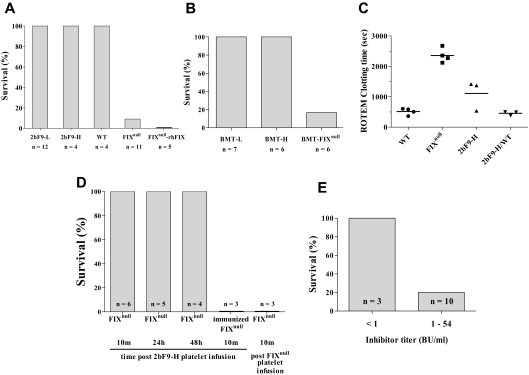Figure 5.
Phenotypic correction of hemophilia B mice. (A) All 2bF9-L and 2bF9-H mice survived the tail clip test. FIXnull-rhFIX are FIXnull mice infused with 1.6% rhFIX (BeneFIX) intravenously. (B) All BMT-L and BMT-H mice survived the tail clip test. BMT-FIXnull are FIXnull mice that received BMT from FIXnull mice as a control. (C) ROTEM clotting time of whole blood. 2bF9-H/WT indicates 2bF9-H mice on wild-type background. Bars represent the mean in each group. Clotting times were significantly decreased in 2bF9-H compared with FIXnull mice (P < .01). No difference was found between WT and 2bF9-H/WT (P = .46). (D) Washed mouse platelets were transfused into FIXnull mice to attain the level of 30% of total recipient platelets. Tail clippings were performed at 10 minutes (10m), 24 hours (24h), and 48 hours (48h) after 2bF9-H platelet infusion. 2bF9-H platelets were also infused into rhFIX-immunized FIXnull mice (immunized FIXnull), which had developed anti-FIX inhibitors ranging from 2 to 12 BU/mL. FIXnull platelets were infused into FIXnull mice (FIXnull platelet infusion) as a control. For the latter 2 groups, tail clippings were performed 10 minutes after infusion. No mice survived in these 2 groups. (E) 2bF9-H mice that received splenocytes from immunized FIXnull mice and had developed FIX inhibitory antibodies were challenged with tail clipping. Splenocyte-transplanted mice with inhibitor titers less than 1 BU/mL were used as controls. Only 2 of 10 mice that maintained inhibitors higher than 1 BU/mL survived tail clipping. These results demonstrate that platelet-derived FIX improved hemostasis in hemophilia B mice but is less effective in mice with anti-FIX inhibitory antibodies.

